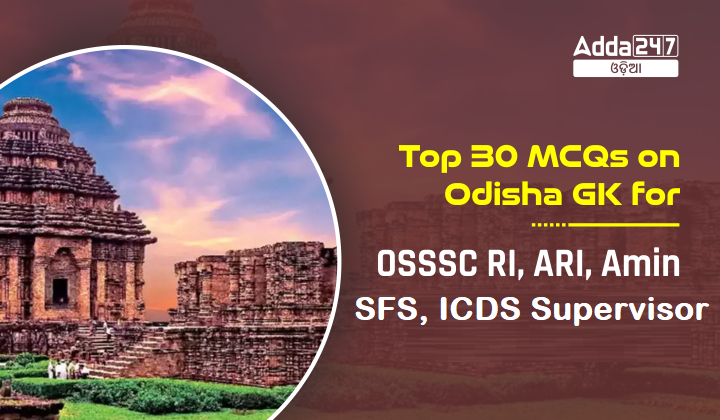General Knowledge is a crucial component of competitive exams, and when it comes to Odisha, a rich tapestry of history, culture, and geography awaits exploration. As you prepare for OSSSC RI, ARI, Amin, SFS, ICDS Supervisor exams, mastering Odisha GK is indispensable. This article presents a curated set of Top 30 Odisha General Knowledge Multiple-Choice Questions (MCQs) to sharpen your knowledge base and boost your exam readiness.
Top 30 Odisha GK MCQS For OSSSC RI,ARI, Amin, SFS, ICDS Supervisor
Here’s a curated list of 30 moderate-level multiple-choice questions (MCQs) based on previous year papers, accompanied by their answers, to help you ace your upcoming examinations:
- Human history in Odisha began in which era?
[A] Upper Paleolithic
[B] Lower Paleolithic
[C] Mesolithic
[D] Chalcolithic
Correct Answer: B [Lower Paleolithic]
Explanation: The lower Paleolithic era marks the beginning of human history in Odisha, which lasted from 2 million BC up to 10000 BC. - Who divided Kalinga into three divisions?
[A] Pliny
[B] Curtius
[C] Plutarch
[D] Diodorus
Correct Answer: A [Pliny]
Explanation: Pliny, the foreign historian, divided Kalinga into three divisions: Gangarides, Maceo, and Calingae. - Which period of history is associated with the beginning of human settlement in Odisha?
[A] Upper Paleolithic
[B] Mesolithic
[C] Neolithic
[D] Chalcolithic
Correct Answer: B [Mesolithic]
Explanation: The Mesolithic period is associated with the beginning of human settlement in Odisha, following the Lower Paleolithic era. - During which era did hunting and food gathering serve as the main professions of humans in Odisha?
[A] Upper Paleolithic
[B] Mesolithic
[C] Neolithic
[D] Chalcolithic
Correct Answer: A [Upper Paleolithic]
Explanation: Hunting and food gathering were the main professions of humans during the Upper Paleolithic era in Odisha. - Who was the foreign historian who mentioned the three parts of Kalinga?
[A] Pliny
[B] Curtius
[C] Plutarch
[D] Diodorus
Correct Answer: A [Pliny]
Explanation: Pliny, the foreign historian, mentioned the three parts of Kalinga as Gangarides, Maceo, and Calingae. - Which period of history followed the Lower Paleolithic era in Odisha?
[A] Mesolithic
[B] Neolithic
[C] Chalcolithic
[D] Iron Age
Correct Answer: A [Mesolithic]
Explanation: The Mesolithic period followed the Lower Paleolithic era in Odisha, marking the beginning of human settlement and the transition to more sophisticated tools and lifestyles. - Which of the following factors contributed to the Gumsar Rebellion?
[A] Suppression of Meriah
[B] Forceful collection of land revenue up to 50%
[C] Death of Dhananjay Bhanja
[D] All of the aboveCorrect Answer: D [All of the above]
Explanation: The Gumsar Rebellion was triggered by a combination of factors including the suppression of the Meriah community, forceful collection of high land revenue, and the death of Dhananjay Bhanja. The discontent among the people due to these reasons culminated in the rebellion.
- When is Odisha Day celebrated?
[A] 26th February
[B] 1st April
[C] 3rd April
[D] 9th AprilCorrect Answer: B [1st April]
Explanation: Odisha Day, also known as Utkala Divas, is celebrated on 1st April. On this day in 1936, Odisha became a separate province on a linguistic basis.
- Who led the Gumsar Rebellion?
[A] Dhananjay Bhanja
[B] Dora Bisoi
[C] Chakhi Khuntia
[D] Raghunath NayakCorrect Answer: C [Chakhi Khuntia]
Explanation: Chakhi Khuntia was one of the leaders of the Gumsar Rebellion which took place in the Gumsar region of Odisha in the 1830s.
- What was the primary cause of the Gumsar Rebellion?
[A] Economic exploitation by British landlords
[B] Religious suppression by colonial authorities
[C] Cultural imperialism by foreign missionaries
[D] Oppression and exploitation of tribal communitiesCorrect Answer: D [Oppression and exploitation of tribal communities]
Explanation: The primary cause of the Gumsar Rebellion was the oppression and exploitation faced by tribal communities, particularly the Meriah tribe, at the hands of colonial authorities and local landlords.
- What significant event occurred on 1st April 1936 in Odisha?
[A] Independence from British rule
[B] Formation of a separate linguistic province
[C] Declaration of statehood
[D] Implementation of major land reformsCorrect Answer: B [Formation of a separate linguistic province]
Explanation: On 1st April 1936, Odisha became a separate linguistic province, marking a significant milestone in the history of the region.
- Who was Dhananjay Bhanja and why was his death significant?
[A] A British colonial official who suppressed tribal uprisings
[B] A tribal leader who spearheaded resistance against British rule
[C] A local landlord known for exploiting peasants
[D] A ruler whose death triggered the Gumsar RebellionCorrect Answer: D [A ruler whose death triggered the Gumsar Rebellion]
Explanation: Dhananjay Bhanja’s death was significant as it served as an immediate trigger for the Gumsar Rebellion due to the discontent and grievances among the people.
- What was the outcome of the Gumsar Rebellion?
[A] Suppression of the rebellion and further exploitation of tribal communities
[B] Negotiated settlement leading to improved rights for tribal populations
[C] Independence of Odisha from British rule
[D] Emergence of tribal autonomy in the regionCorrect Answer: A [Suppression of the rebellion and further exploitation of tribal communities]
Explanation: Unfortunately, the Gumsar Rebellion was suppressed by the colonial authorities, leading to further exploitation of tribal communities and a continuation of oppressive policies.
- How many states does Odisha share its boundary with?
[A] 3
[B] 4
[C] 5
[D] 2Correct Answer: B [4]
Explanation: Odisha shares its boundary with four states: Andhra Pradesh to the south, Chhattisgarh to the west, and Jharkhand and West Bengal to the north.
- In which district is the capital city of Odisha, Bhubaneswar, situated?
[A] Deogarh
[B] Koraput
[C] Khordha
[D] BalasoreCorrect Answer: C [Khordha]
Explanation: Bhubaneswar, the capital city of Odisha, is situated in Khordha district. It lies southwest of the Mahanadi river.
- Which part of the Rushikulya Plain is often compared with the Sundarbans?
[A] Arable Tract
[B] Salt Tract
[C] Sub-Montane Tract
[D] None of the aboveCorrect Answer: B [Salt Tract]
Explanation: The Salt Tract of the Rushikulya Plain is often compared with the Sundarbans. This area is covered with tidal forests.
- Which river is not associated with Odisha?
[A] Brahmani
[B] Godavari
[C] Mahanadi
[D] SubarnarekhaCorrect Answer: B [Godavari]
Explanation: While the Brahmani, Mahanadi, and Subarnarekha rivers are associated with Odisha, the Godavari river primarily flows through the states of Maharashtra, Telangana, Andhra Pradesh, and Chhattisgarh.
- Which national park is located in Odisha?
[A] Bandhavgarh National Park
[B] Kaziranga National Park
[C] Simlipal National Park
[D] Sundarbans National ParkCorrect Answer: C [Simlipal National Park]
Explanation: Simlipal National Park is located in Odisha. It is known for its biodiversity and is one of the largest tiger reserves in India.
- Which festival is celebrated with the most enthusiasm in Odisha?
[A] Durga Puja
[B] Diwali
[C] Rath Yatra
[D] NavratriCorrect Answer: C [Rath Yatra]
Explanation: Rath Yatra, the chariot festival dedicated to Lord Jagannath, is celebrated with the most enthusiasm in Odisha, especially in the city of Puri.
- What is the traditional dance form of Odisha called?
[A] Kathakali
[B] Bharatanatyam
[C] Odissi
[D] KuchipudiCorrect Answer: C [Odissi]
Explanation: Odissi is the traditional dance form of Odisha, characterized by its graceful movements and intricate footwork.
- Which hill range separates Odisha from its neighboring state Chhattisgarh?
[A] Eastern Ghats
[B] Satpura Range
[C] Vindhya Range
[D] Aravalli RangeCorrect Answer: A [Eastern Ghats]
Explanation: The Eastern Ghats separate Odisha from its neighboring state Chhattisgarh.
- Which of the following is a UNESCO World Heritage Site in Odisha?
[A] Konark Sun Temple
[B] Lingaraja Temple
[C] Chilika Lake
[D] Sanchi StupaCorrect Answer: [A] Konark Sun Temple
Explanation: The Konark Sun Temple is indeed a UNESCO World Heritage Site located in Odisha, India.
- What deity is the Konark temple dedicated to?
[A] Lord Shiva
[B] Lord Vishnu
[C] Lord Surya (Sun God)
[D] Lord GaneshaCorrect Answer: C [Lord Surya (Sun God)]
- How many wheels adorn the monumental representation of the sun god Surya’s chariot at the Konark temple?
[A] 12
[B] 18
[C] 24
[D] 30Correct Answer: C [24]
- In which century was the Konark Sun Temple built?
[A] 10th century
[B] 12th century
[C] 13th century
[D] 15th centuryCorrect Answer: C [13th century]
- Who is credited with the construction of the Konark Sun Temple?
[A] Chandragupta Maurya
[B] Narasinga Deva I
[C] Ashoka the Great
[D] HarshavardhanaCorrect Answer: B [Narasinga Deva I]
Explanation: The Konark Sun Temple is attributed to King Narasinga Deva I of the Eastern Ganga Dynasty, who ruled during the 13th century CE. He commissioned the construction of this magnificent temple dedicated to the Sun God, Surya.
- Where is the Konark Sun Temple located?
[A] South of Puri
[B] West of Bhubaneswar
[C] Northeast of Puri
[D] Southeast of CuttackCorrect Answer: C [Northeast of Puri]
Explanation: The Konark Sun Temple is situated northeast of Puri on the coastline of Odisha, India. Puri is a famous pilgrimage city located on the eastern coast of India.
- When was the Konark Sun Temple declared a UNESCO World Heritage Site?
[A] 1965
[B] 1975
[C] 1984
[D] 1994Correct Answer: C [1984]
Explanation: The Konark Sun Temple was recognized as a UNESCO World Heritage Site in the year 1984. This designation signifies its outstanding universal value and cultural significance, leading to its preservation and conservation for future generations to appreciate.
- Which state government announced a ‘Research Fund’ for medical colleges and institutes to boost medical research?
[A] Odisha
[B] Karnataka
[C] Maharashtra
[D] Tamil NaduCorrect Answer: A [Odisha]
Explanation: The key points mentioned, such as the provision of funds and objectives, indicate that the announcement was made by the state government of Odisha to boost medical research.
- Which organizations organized the Odisha Wildlife Conclave 2024?
[A] Ever Green Forum and the Indian Chamber of Commerce (ICC)
[B] United Nations and the World Wildlife Fund (WWF)
[C] Wildlife Conservation Society and National Geographic Society
[D] Greenpeace and World Wide Fund for Nature (WWF)Correct Answer: A [Ever Green Forum and the Indian Chamber of Commerce (ICC)]
Explanation: The provided key points mention that the Odisha Wildlife Conclave 2024 was organized by the Ever Green Forum and the Indian Chamber of Commerce (ICC), showcasing the state’s achievements in wildlife conservation, research, and management.










